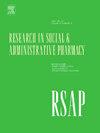Psychometric properties of the caregiver contribution to self-care of oral anticancer agents index: Longitudinal study
IF 3.7
3区 医学
Q1 PUBLIC, ENVIRONMENTAL & OCCUPATIONAL HEALTH
Research in Social & Administrative Pharmacy
Pub Date : 2025-01-26
DOI:10.1016/j.sapharm.2025.01.013
引用次数: 0
Abstract
Background
The use of oral anticancer agents (OAAs) has increased in recent decades. Despite the advantages of OAAs, people with cancer face challenges such as adherence, prevention, recognition, and management of OAA side effects. Informal caregivers can help their patients who take OAAs by facing the above challenges with the implementation of behaviours to maintain stability (Caregiver contribution to self-care maintenance), monitoring (Caregiver contribution to self-care monitoring) and managing (Caregiver contribution to self-care management) the conditions of their patients.
Objective
To develop and test the psychometric properties of the Caregiver Contribution to self-care in the Oral Anticancer Agents Index (CC-SCOAAI).
Methods
A longitudinal study was conducted. Factorial validity was tested using Confirmatory Factor Analysis (CFA). Furthermore, we also tested the internal consistency and validity of the CC-SCOAAI construct. The Mann-Whitney U test was used to demonstrate associations between CC-SCOAAI scores and patient's re-hospitalizations, emergency-room attendances, and mortality.
Results
We enrolled 318 caregivers, mostly female (63.52 %), with an age of <44 (39.94 %) and spouse of the patient (54.66 %). The CFA demonstrated the factorial validity of the CC-SCOAAI. Caregivers of patients with more re-hospitalizations had a lower contribution to self-care maintenance (U = 2933.500; p = .04), while caregivers of patients with more emergency room admissions (U = 1392.500; p < .001) and re-hospitalizations (U = 2385.500; p < .001) had a lower contribution to self-care management. Caregivers of patients with emergency-room admissions (U = 1392.500; p = .005), re-hospitalisations (U = 2322.500; p < .001) and mortality (U = 515.500; p = .001) had lower contribution to self-care monitoring.
Conclusions
CC-SCOAAI is a valid and reliable tool. Given that caregivers are crucial in supporting these patients, the CC-SCOAAI may help clinicians improve caregiver efficacy and researchers using CC-SCOAAI to determine better self-care outcomes in patients with OAA.
口服抗癌药护理人员自我护理贡献指数的心理计量特性:纵向研究。
背景:近几十年来,口服抗癌药物(OAAs)的使用有所增加。尽管OAA具有优势,但癌症患者面临着诸如坚持、预防、识别和管理OAA副作用等挑战。面对上述挑战,非正式照护者可以通过实施患者状况的维持稳定(照护者贡献于自我护理维持)、监测(照护者贡献于自我护理监测)和管理(照护者贡献于自我护理管理)行为来帮助接受OAAs的患者。目的:开发并检验口服抗癌药物指数(CC-SCOAAI)中护理者自我护理贡献的心理测量特征。方法:采用纵向研究。用验证性因子分析(CFA)检验因子效度。此外,我们还检验了CC-SCOAAI结构的内部一致性和效度。Mann-Whitney U检验用于证明CC-SCOAAI评分与患者再住院、急诊室就诊和死亡率之间的关联。结果:共纳入318名护理人员,女性居多(63.52%),年龄为:结论:CC-SCOAAI是一种有效可靠的工具。考虑到护理人员对这些患者的支持至关重要,CC-SCOAAI可以帮助临床医生提高护理人员的效能,研究人员使用CC-SCOAAI来确定OAA患者更好的自我护理结果。
本文章由计算机程序翻译,如有差异,请以英文原文为准。
求助全文
约1分钟内获得全文
求助全文
来源期刊

Research in Social & Administrative Pharmacy
PUBLIC, ENVIRONMENTAL & OCCUPATIONAL HEALTH-
CiteScore
7.20
自引率
10.30%
发文量
225
审稿时长
47 days
期刊介绍:
Research in Social and Administrative Pharmacy (RSAP) is a quarterly publication featuring original scientific reports and comprehensive review articles in the social and administrative pharmaceutical sciences. Topics of interest include outcomes evaluation of products, programs, or services; pharmacoepidemiology; medication adherence; direct-to-consumer advertising of prescription medications; disease state management; health systems reform; drug marketing; medication distribution systems such as e-prescribing; web-based pharmaceutical/medical services; drug commerce and re-importation; and health professions workforce issues.
 求助内容:
求助内容: 应助结果提醒方式:
应助结果提醒方式:


